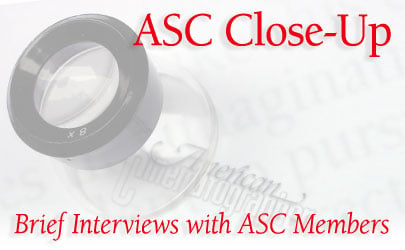 |
||||
 |
|
|||
| John Simmons, ASC |
|
|||
When you were a child, what film made the strongest impression on you? When I was about 7, my father brought home a 16mm projector and a box of films. The films were black-and-white documentaries about faraway places — India, Africa and the Grand Canyon, far away from Chicago. I learned how to work the projector, and my friends and I would screen them in my basement. I can remember how much those films would move my imagination. I’d drive my friends crazy wanting to watch those things over and over. Which cinematographers, past or present, do you most admire? There are so many great cinematographers I admire, especially [ASC members] Gregg Toland, Conrad Hall and Jordan Cronenweth. I particularly admire James Wong Howe, ASC, not only because of his brilliant work but also because of his ability to excel in an environment that presented challenges, especially racial barriers, that he had to transcend. I can relate to that. Presently, there are so many wonderful cinematographers whom I respect and admire that I can’t name them all without leaving some truly important ones out. What sparked your interest in photography? When I was 15, I was given a book called The Sweet Flypaper of Life by Roy DeCarava. The photography in that book found me and showed me what I wanted to do. I started taking pictures that same year. Where did you train and/or study? Bobby Sengstacke, who documented the civil-rights era, taught me photography/processing/printing. He put me to work at the Chicago Defender newspaper and exposed me to Henri Cartier Bresson, Gordon Parks, Walker Evans and many others. He helped me to see my direction. I studied fine art and painting at Fisk University and I attended film school at the University of Southern California. Who were your early teachers or mentors? My greatest mentor was writer/director Carlton Moss, who came to Fisk University once a month to teach a film class. He looked at one of my Super 8 films and said, ‘Simmons, you’re a cinematographer.’ He sent me a 16mm camera from his friend Cal Bernstein at Dove Films and gave me film. I messed up a lot of film! Carlton’s friend, Stu Hiesler, helped me understand the elements of drama, and at Wexler Films I met Sin Hock Gaw, who trained me as a camera assistant. Woody Omens, ASC was my most influential teacher at USC. I owe so much to all of these people. What are some of your key artistic influences? I am a painter, and I love studying paintings. It’s such a wonderful way to learn about light and shadow, as well as the artistic license taken by artists. How did you get your first break in the business? My first job shooting was with Carlton Moss. He directed and produced a series of biographical documentaries on the lives of famous African Americans. We were a two-man crew, and we shot all over the country. What has been your most satisfying moment on a project? Tim Reid gave me my first feature, a coming-of-age period piece called Once Upon A Time When We Were Colored. He looked at my music-video reel and gave me a chance. That was a giant step for me. We studied paintings and photographs from the WPA and re-created a look that I’m still pleased with. Have you made any memorable blunders? I’m a tough critic on myself. I’ve made many blunders and have gotten away with them. I just try not to make them twice — unless they’re really good ones. What’s the best professional advice you’ve ever received? Lose the word ‘can’t’ from your vocabulary. Carlton Moss taught me there is always a way to get it done. What recent books, films or artworks have inspired you? I enjoy watching music videos because they’re always on the cutting edge. I also shoot lots of stills and am constantly inspired by photography. Do you have any favorite genres, or genres you would like to try? I would like to make an action film or a musical. If you weren’t a cinematographer, what might you be doing instead? Painting. Which ASC members recommended you for membership? Judy Irola, Bill Dill and Isidore Mankofsky. How has ASC membership impacted your life and career? Cinematography is a journey. It’s always in a constant state of becoming, and there is nothing static about it. The choices I’ve made in the past have put me where I am. All along the way, I’ve wondered whether I should have done this or done that — we do what’s most important at the time. Becoming a member of the ASC was the most important moment of my career. To be embraced as a peer by the most incredible cinematographers in the world has given significance to every moment I’ve spent behind the camera. It is a point of arrival and departure. I’ve become a part of history in a way I never thought would happen. Joining the ASC is a dream come true for any cinematographer. |
|
|||
|
<< prev |
||||
|
|
|
|
|
|


